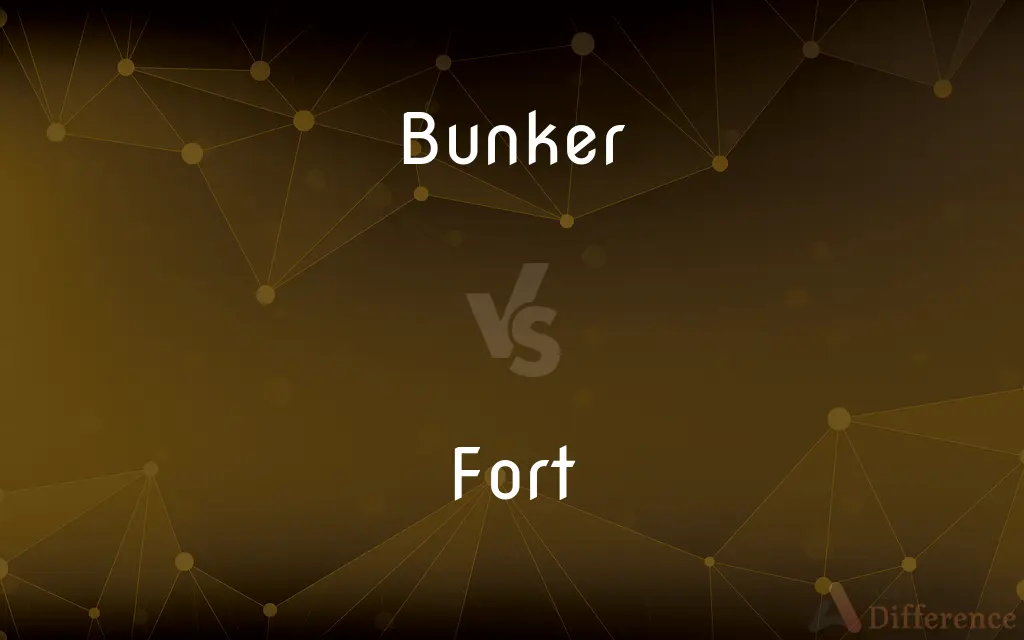Bunker vs. Fort — What's the Difference?
By Maham Liaqat & Fiza Rafique — Updated on April 16, 2024
"Bunker" typically refers to a reinforced underground shelter designed for protection against bombs or other attacks, while a "fort" is a fortified building or military stronghold used to defend against enemy attacks.

Difference Between Bunker and Fort
Table of Contents
ADVERTISEMENT
Key Differences
A bunker is primarily designed as a protective measure, often underground, to shield against explosions, attacks, or disasters. Forts, on the other hand, are built to serve as military bases from which to defend or control an area, usually constructed above ground with walls, barriers, and defensive positions.
Bunkers are commonly found in both military and civilian applications, providing safety during bombings or natural disasters. Whereas forts are almost exclusively military, intended for prolonged use in warfare or as barracks, command centers, and arms storage.
The construction of a bunker emphasizes concealment and resilience, often using reinforced concrete and steel. Forts focus on strategic location and defensive strength, utilizing earthworks, stone, or other durable materials to withstand sieges.
In terms of usage, bunkers are often temporary refuges during specific threats like air raids. Forts, by contrast, are used continuously as part of military operations, offering a place to plan, command, and manage resources.
While bunkers provide a passive form of protection, primarily to preserve life during attacks, forts are active military installations used to exert control and project power over a region, often engaging directly with enemy forces.
ADVERTISEMENT
Comparison Chart
Primary Function
Defensive shelter
Military stronghold
Typical Location
Underground
Above ground
Construction Materials
Reinforced concrete, steel
Stone, earthworks, wood
Usage Context
Temporary refuge
Prolonged military use
Strategic Purpose
Protection and survival
Defense and control
Compare with Definitions
Bunker
A sand trap in golf, not related to military use.
His ball landed in the bunker on the 18th hole.
Fort
Used metaphorically to describe a strong, secure place.
Their home was a fort against the outside world.
Bunker
An underground shelter built to protect against bombs or attacks.
They took shelter in the bunker during the air raid.
Fort
A fortified building or set of buildings used for defense in military operations.
The old fort overlooks the bay.
Bunker
A safe room in civilian settings.
The family built a storm bunker in their backyard.
Fort
A children’s play structure resembling a military fort.
The kids played in the wooden fort all afternoon.
Bunker
A storage place for hazardous materials.
The chemical bunker stores all the toxic waste safely.
Fort
Historical fortifications used in colonial wars.
We visited a fort that was key during the Revolutionary War.
Bunker
A bunker is a defensive military fortification designed to protect people and valued materials from falling bombs or other attacks. Bunkers are mostly underground, in contrast to blockhouses which are mostly above ground.
Fort
A fortified place or position for the stationing of troops.
Bunker
A bin or tank especially for fuel storage, as on a ship.
Fort
A permanent army post.
Bunker
Often bunkers Fuel, such as coal or fuel oil, used especially in ships.
Fort
A fortified defensive structure stationed with troops.
Bunker
(Sports) See sand trap.
Fort
Any permanent army post.
Bunker
To store or place (fuel) in a bunker.
Fort
(historical) An outlying trading-station, as in British North America.
Bunker
(Sports) To hit (a golf ball) into a sand trap.
Fort
A structure improvised from furniture, bedding, etc., for playing games.
The kids built a fort out of chairs and pillows.
Bunker
(military) A hardened shelter, often partly buried or fully underground, designed to protect the inhabitants from falling bombs or other attacks.
Fort
To create a fort, fortifications, a strong point, or a redoubt.
Bunker
(nautical) A container for storing coal or fuel oil for a ship's engine; (by extension) the quantity of fuel needed to replenish that container.
Fort
A strong or fortified place; usually, a small fortified place, occupied only by troops, surrounded with a ditch, rampart, and parapet, or with palisades, stockades, or other means of defense; a fortification.
Detached works, depending solely on their own strength, belong to the class of works termed forts.
Bunker
(rail transport) The coal compartment on a tank engine.
Fort
A fortified military post where troops are stationed
Bunker
(sports)
Fort
A fortified defensive structure
Bunker
(golf) A hazard on a golf course consisting of a sand-filled hollow.
Fort
Gather in, or as if in, a fort, as for protection or defense
Bunker
(paintball) An obstacle used to block an opposing player's view and field of fire.
Fort
Enclose by or as if by a fortification
Bunker
A large bin or container for storing coal, often built outdoors in the yard of a house.
Fort
Station (troops) in a fort
Bunker
(Scotland)
Bunker
A sort of box or chest, as in a window, the lid of which serves as a seat.
Bunker
(slang) A kitchen worktop.
Bunker
One who bunks off; a truant from school.
Bunker
The menhaden, any of several species of fish in the genera Brevoortia and Ethmidium.
Bunker
(nautical)
Bunker
(transitive) To load (a vessel) with coal or fuel oil for the engine.
Bunker
To take a load of coal or fuel oil for its engine.
Bunker
To steal bunker fuel by illicitly siphoning it off.
Bunker
To hit (a golf ball) into a bunker; to place (a golfer) in the position of having a golf ball in a bunker.
Bunker
To place (someone) in a position that is difficult to get out of; to hinder.
Bunker
To fire constantly at (an opponent hiding behind an obstacle), trapping them and preventing them from firing at other players; also, to eliminate (an opponent behind an obstacle) by rushing to the position and firing at extremely close range as the player becomes exposed.
Bunker
(intransitive) Often followed by down: to take shelter in a bunker or other place.
Bunker
A sort of chest or box, as in a window, the lid of which serves for a seat.
Bunker
A large bin or similar receptacle; as, a coal bunker.
Bunker
A small sand hole or pit, as on a golf course.
Bunker
Hence, any rough hazardous ground on the links; also, an artificial hazard with built-up faces.
Bunker
A fortified position dug into the ground, especially one which is closed on top and has protective walls and roof, e. g. of reinforced concrete. For defending positions it usually has windows to view the surrounding terrain, but as a safe location for planning operations or storage, a bunker may be completely underground with no direct access to the surface.
Bunker
To drive (the ball) into a bunker.
Bunker
A hazard on a golf course
Bunker
A fortification of earth; mostly or entirely below ground
Bunker
Hit a golf ball into a bunker
Bunker
Fill (a ship's bunker) with coal or oil
Bunker
Transfer cargo from a ship to a warehouse
Common Curiosities
What kinds of materials are used to build a fort?
Typically durable materials like stone, wood, or earthworks.
Are forts still used today?
Yes, they are used as military bases, historical sites, and sometimes as tourist attractions.
Can bunkers be used for purposes other than warfare?
Yes, they can be used as shelters during natural disasters or for storing hazardous materials.
What historical significance do forts have?
Many forts are significant in history for their roles in wars and conflicts across different eras.
Can a bunker be above ground?
Some bunkers can be partially above ground but are typically heavily fortified.
What is the primary purpose of a bunker?
To provide protection against attacks, particularly aerial or explosive.
How does a fort differ from a bunker in terms of visibility?
Forts are typically above ground and visible, while bunkers are usually underground and concealed.
How do children use the concept of a fort in play?
They often build play forts to emulate military forts, using them as places for games and imagination.
What role do bunkers play in modern military strategy?
They provide a secure location to safeguard personnel and equipment during conflicts.
What is a common civilian use of a fort today?
Many are converted into museums, cultural sites, or venues for special events.
Share Your Discovery

Previous Comparison
Exercise vs. Homework
Next Comparison
Toluene vs. TurpentineAuthor Spotlight
Written by
Maham LiaqatCo-written by
Fiza RafiqueFiza Rafique is a skilled content writer at AskDifference.com, where she meticulously refines and enhances written pieces. Drawing from her vast editorial expertise, Fiza ensures clarity, accuracy, and precision in every article. Passionate about language, she continually seeks to elevate the quality of content for readers worldwide.













































